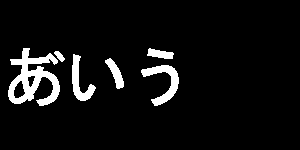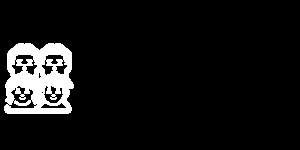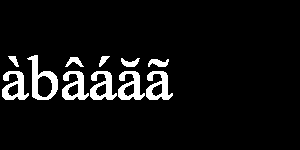スポンサーリンク
std::u32stringをFreeType2+HarfBuzzで描画する処理を関数化
諸事情により、以前作成したFreeType2+HarfBuzzのコードを関数化する。
HarfBuzzを使いまわす場合、バッファのクリアが必要となり、hb_buffer_clear_contentsを使用する。
render_font.hpp
#pragma once #ifdef _DEBUG #pragma comment(lib,"freetyped.lib") #pragma comment(lib,"harfbuzz.lib") #else #pragma comment(lib,"freetype.lib") #pragma comment(lib,"harfbuzz.lib") #endif #include <ft2build.h> #include FT_FREETYPE_H #include <hb.h> #include <hb-ft.h>
struct Image { int imageWidth; int imageHeight; std::vector<unsigned char> image; Image(int w, int h) { image.resize(w * h); imageWidth = w; imageHeight = h; } //! @brief imageへの書き込み時のピクセル計算 int pixel_pos(const int x, const int y) { return y * imageWidth + x; } bool is_valid_area(int xx, int yy) { if (xx < 0)return false; if (yy < 0)return false; if (xx >= imageWidth)return false; if (yy >= imageHeight)return false; return true; } };
//! @brief imageへbmpの内容を書き込む //! @param [in] bmp 文字画像 //! @param [in] startx image画像内の書き込み開始位置 //! @param [in] starty image画像内の書き込み開始位置 void draw(Image* image, const FT_Bitmap& bmp, int startx, int starty) { int Width = bmp.width; int Height = bmp.rows; for (size_t y = 0; y < Height; y++) { for (size_t x = 0; x < Width; x++) { int xx = startx + x; int yy = starty + y; if( image->is_valid_area(xx, yy) == false)continue; if (bmp.buffer[y * Width + x]) { (image->image)[image->pixel_pos(xx, yy)] = 1; } } } }
//! @brief フォントの読込 FreeType2の処理 //! @param [in] library FT_Library //! @param [in] fontfile フォントファイルへのパス //! @return フェイスオブジェクト FT_Face* my_LoadFonts( FT_Library& library, const char* fontfile ) { FT_Face* face = new FT_Face; FT_Error error; // フォントファイル読み込み error = FT_New_Face( library, fontfile, 0, face ); //文字コード指定 error = FT_Select_Charmap( *face, FT_ENCODING_UNICODE // エンコード指定 ); if (error == FT_Err_Unknown_File_Format) return nullptr; else if (error) return nullptr; int pixel_size_y = 64; error = FT_Set_Pixel_Sizes( *face, 0, pixel_size_y); return face; }
//! @brief HarfBuzzで計算した座標を使いFreeType2で文字列を描画する //! @param [in] image 描画先 //! @param [in] hbbuf HarfBuzzオブジェクト //! @param [in] face FreeType2のフェイス void my_FaceDraw(Image* image, hb_buffer_t* hbbuf, FT_Face* face) { // 描画先をクリア std::fill(image->image.begin(), image->image.end(), 0); //文字数を格納 (書記素数ではない。例えば「あ゙」は2文字) unsigned int glyph_count; hb_glyph_info_t* glyph_info = hb_buffer_get_glyph_infos(hbbuf, &glyph_count); hb_glyph_position_t* glyph_pos = hb_buffer_get_glyph_positions(hbbuf, &glyph_count); hb_position_t cursor_x = 0; hb_position_t cursor_y = 0; // 各文字ごとに描画する for (unsigned int i = 0; i < glyph_count; i++) { // codepointという変数名だが実際にはグリフインデクスが入っている hb_codepoint_t glyphid = glyph_info[i].codepoint; // 一文字分のオフセット。本来描画される位置からどれぐらいずれるか hb_position_t x_offset = glyph_pos[i].x_offset >> 6;// 結合文字の゛は本来の位置より左側に描画するので hb_position_t y_offset = glyph_pos[i].y_offset >> 6;// x_offsetにはマイナスの値が入る // 次の文字の描画開始位置までのピクセル数 hb_position_t x_advance = glyph_pos[i].x_advance >> 6; hb_position_t y_advance = glyph_pos[i].y_advance >> 6; /////////////////////////////////////// /////////////////////////////////////// /////////////////////////////////////// FT_Error error = FT_Load_Glyph(*face, glyphid, FT_LOAD_RENDER); if (error) { continue; } // 文字を画像化 FT_Render_Glyph((*face)->glyph, FT_RENDER_MODE_NORMAL); // 画像書き込み // オフセットを加えて座標調整する draw( image, (*face)->glyph->bitmap, cursor_x + x_offset + (*face)->glyph->bitmap_left, cursor_y + y_offset - (*face)->glyph->bitmap_top + 100 ); /////////////////////////////////////// /////////////////////////////////////// /////////////////////////////////////// // 次の文字の描画開始値 cursor_x += x_advance; cursor_y += y_advance; } }
void render_by_font( Image* image, FT_Face* ft_face, const std::u32string& text, hb_script_t script, hb_buffer_t* hbbuf, hb_font_t* hbfont, std::string lang ) { // バッファの内容をクリア // hb_buffer_tを再利用するときは、hb_buffer_clear_contents()でバッファをクリアする hb_buffer_clear_contents(hbbuf); // バッファにテキストを追加 hb_buffer_add_utf32(hbbuf, (const std::uint32_t*)text.data(), -1, 0, -1);// 描画したいテキストの設定 hb_buffer_set_direction(hbbuf, HB_DIRECTION_LTR); // 文字の方向を左から右として設定 hb_buffer_set_script(hbbuf, script); // Unicodeの用字(Script)として日本語を指定 hb_buffer_set_language(hbbuf, hb_language_from_string(lang.c_str(), -1));// 言語として日本語を設定 //////////////////////// hb_shape(hbfont, hbbuf, NULL, 0); //////////////////////// my_FaceDraw(image,hbbuf, ft_face);//FreeType2とHarfBuzzで文字列描画 //////////////////////// }
main.cpp
#include <iostream> #include <vector> #include <fstream> #include <filesystem> #include <unordered_map> #include"render_font.hpp" #pragma warning(disable:4996) #include <string> #include <array> //! @brief PBM(1byte,テキスト)を書き込む //! @param [in] fname ファイル名 //! @param [in] width 画像の幅 //! @param [in] height 画像の高さ //! @param [in] p 画像のメモリへのアドレス //! @details 1画素1Byteのメモリを渡すと、0,1テキストでファイル名fnameで書き込む void pbmP1_Write(const char* const fname, const int width, const int height, const unsigned char* const p);
//! @brief フォント情報を管理 struct FaceInfo { FT_Face* face; // フェイス(Freetype) hb_font_t* hbfont; // フェイス(HarfBuzz) hb_script_t script; // Unicodeの用字(=Script) std::string lang; // HarfBuzzに指定する言語 FaceInfo(FT_Face* f, hb_script_t s, const char* l) : face(f), script(s), lang(l) { // フォントオブジェクト作成 hbfont = hb_ft_font_create(*face, nullptr); } FaceInfo(FaceInfo&& fr){ face = fr.face; script = fr.script; lang = fr.lang; hbfont = fr.hbfont; fr.face = nullptr; fr.hbfont = nullptr; } // フォント破棄 void Delete() { if (hbfont) hb_font_destroy(hbfont); if (face) FT_Done_Face(*face); } };
int main() { FT_Library library; // handle to library FT_Error error; error = FT_Init_FreeType(&library); if (error) return -1; // HarfBuzzのオブジェクト作成 hb_buffer_t* hbbuf; hbbuf = hb_buffer_create(); ////////////////////////////////////////////////////// ////////////////////////////////////////////////////// ////////////////////////////////////////////////////// // 出力先を作成 Image image(300, 150); ///////////////////////////////////////////// // フォント情報作成 FaceInfo faces[3] = { FaceInfo( my_LoadFonts(library, "C:\\Windows\\Fonts\\msgothic.ttc"), HB_SCRIPT_HIRAGANA, "jp" ), FaceInfo( my_LoadFonts(library, "C:\\Windows\\Fonts\\seguiemj.ttf"), HB_SCRIPT_HIRAGANA, "jp" ), FaceInfo( my_LoadFonts(library, "C:\\Windows\\Fonts\\Times.ttf"), HB_SCRIPT_LATIN, "en" ) }; ////////////////////////////////////////////////////// ////////////////////////////////////////////////////// ////////////////////////////////////////////////////// { // フォントを使って文字列を描画 render_by_font( &image, faces[0].face, U"あ゙いう", faces[0].script, hbbuf, faces[0].hbfont, faces[0].lang.c_str() ); pbmP1_Write("freetypetest_jp.pbm", image.imageWidth, image.imageHeight, &image.image[0]);// 結果を保存 } { // フォントを使って文字列を描画 render_by_font( &image, faces[1].face, U"👨👨👧👦", faces[1].script, hbbuf, faces[1].hbfont, faces[1].lang.c_str() ); pbmP1_Write("freetypetest_mj.pbm", image.imageWidth, image.imageHeight, &image.image[0]);// 結果を保存 } { // フォントを使って文字列を描画 render_by_font( &image, faces[2].face, U"àbâáăã", faces[2].script, hbbuf, faces[2].hbfont, faces[2].lang.c_str() ); pbmP1_Write("freetypetest_la.pbm", image.imageWidth, image.imageHeight, &image.image[0]);// 結果を保存 } for(auto& f : faces){ f.Delete(); } ///////////////////////////////////////////// ///////////////////////////////////////////// ///////////////////////////////////////////// // HarfBuzzのオブジェクト破棄 hb_buffer_destroy(hbbuf); // FreeType2の解放 FT_Done_FreeType(library); } //! @brief PBM(1byte,テキスト)を書き込む //! @param [in] fname ファイル名 //! @param [in] width 画像の幅 //! @param [in] height 画像の高さ //! @param [in] p 画像のメモリへのアドレス //! @details 1画素1Byteのメモリを渡すと、0,1テキストでファイル名fnameで書き込む void pbmP1_Write(const char* const fname, const int width, const int height, const unsigned char* const p) { // PPM ASCII FILE* fp = fopen(fname, "wb"); fprintf(fp, "P1\n%d\n%d\n", width, height); size_t k = 0; for (size_t i = 0; i < (size_t)height; i++) { for (size_t j = 0; j < (size_t)width; j++) { fprintf(fp, "%d ", p[k] ? 0 : 1); k++; } fprintf(fp, "\n"); } fclose(fp); }
結果



この記事のトラックバックURL: